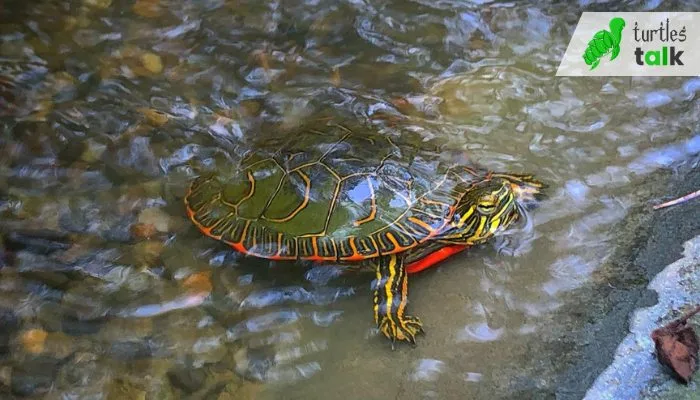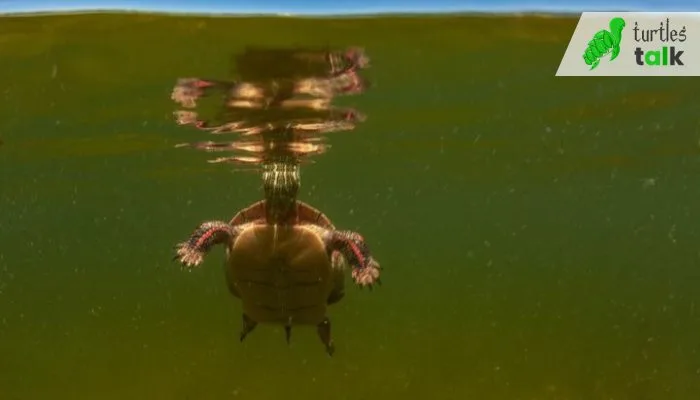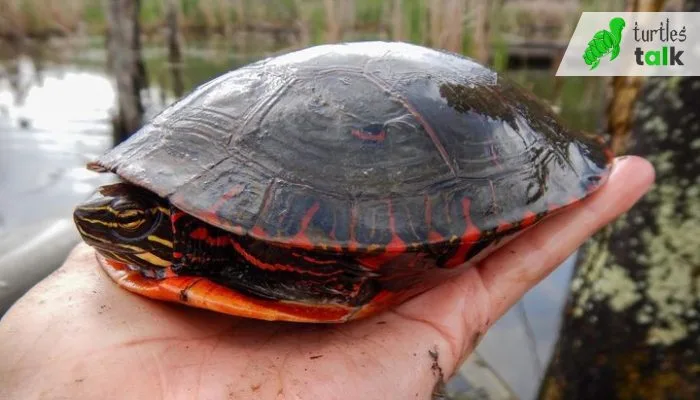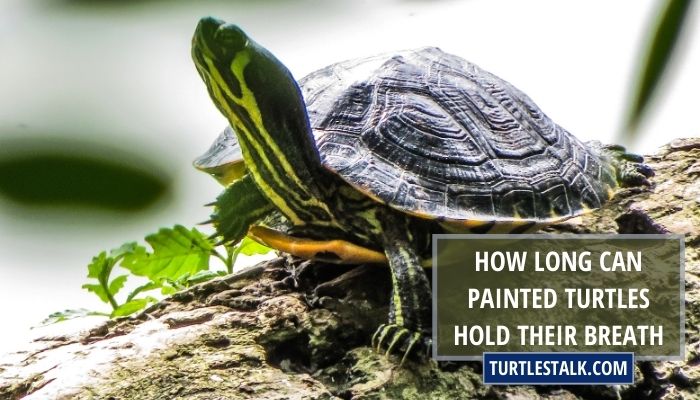How Long Can Painted Turtles Hold Their Breath? – Breath-Holding Wonders
Painted turtles (Chrysemys picta) are one of the most common turtles in North America. These turtles are known for their striking colors and ability to bask in the sun for hours. However, one of the most impressive things about these turtles is their ability to hold their breath for extended periods. Painted turtles are among the longest breath-holders of any turtle species.
A full-grown adult Painted turtle can hold their breath for several hours, and these turtles can live up to 170 days without taking a breath by controlling their metabolic rate in certain extreme weather conditions. When faced with this particular circumstance, they depend on Anaerobic Respiration, which results in the generation of lactic acid.
You’re probably wondering how they can survive oxygen deficiency for so long. This impressive feat can be attributed to their unique physiology, which allows them to remain submerged even when oxygen levels in the water are low.
How Long Can Painted Turtles Stay Underwater Holding Their Breath?
The exact amount of time that a painted turtle can stay underwater holding its breath varies depending on a number of factors, including the turtle’s age, size, and overall health. However, on average, painted turtles can hold their breath for anywhere from 30 minutes to several hours.

There are a few reasons why they are able to stay underwater for such long periods of time.
Anoxia Tolerance
Painted turtles are able to tolerate anoxia is by reducing their metabolic rate. When oxygen levels are low, the turtles slow down their metabolism, which reduces their oxygen consumption and allows them to survive with limited oxygen supply.
Additionally, painted turtles can switch to anaerobic metabolism, which does not require oxygen, to produce energy when oxygen levels are low.
Slow Down Metabolism
One of the main factors is their ability to slow down their metabolism. When a turtle is underwater, it is able to slow down its heart rate and breathing, which allows it to conserve oxygen and stay underwater longer.
Store Oxygen
Another factor that contributes to a turtle’s ability to stay underwater for long periods of time is its ability to store oxygen in its blood. Turtles have a special protein in their blood called hemoglobin, which allows them to store oxygen for later use. This means that even if a turtle runs out of oxygen in its lungs, it can still continue to survive for a short period of time using the oxygen stored in its blood.
Physical Adaptation
They also have certain physical adaptations that allow them to stay underwater for longer periods of time. For example, their shells are streamlined and smooth, which helps them to move through the water more efficiently. They also have webbed feet and strong legs, which allow them to swim quickly and easily.
Hibernation
It’s also worth mentioning that painted turtles have the ability to hibernate underwater for several months. This is a survival technique that allows them to conserve energy and survive in cold temperatures. During this time, they can go without food and breathe through their skin, while they’re hibernating.
How Deep Can Painted Turtles Dive?
Painted turtles are freshwater turtles, and they primarily stay in shallow waters, usually no more than 2-3 feet deep. The reason why painted turtles can dive so deep is because of their physical adaptations. They have strong legs and webbed feet that allow them to swim quickly and easily.

They also have streamlined shells that reduce drag and make it easier for them to move through the water. These adaptations allow painted turtles to swim deeper and stay underwater for longer periods of time.
It’s also worth noting that painted turtles have the ability to hold their breath for a considerable amount of time. They are able to slow down their metabolism and store oxygen in their blood, which enables them to survive underwater for long periods of time. This allows them to stay deeper in the water for longer periods of time.
How Long Can a Turtle Stay Without Oxygen?
One of the most impressive abilities of turtles is their ability to survive without oxygen for extended periods of time. The amount of time a turtle can survive without oxygen depends on various factors. A healthy western-painted turtle can stay without oxygen for up to 30 hours.
In general, they are able to survive without oxygen for a longer period of time than mammals or birds. This is because turtles have a special adaptation called aestivation, which allows them to slow down their metabolism and survive without oxygen for extended periods of time.
Aestivation is a form of hibernation that turtles use to survive in hot and dry conditions. When a turtle enters aestivation, it becomes dormant and stops moving, eating, and drinking. During this time, the turtle’s body temperature drops, its heart rate slows down, and its breathing becomes shallow.
These changes allow the turtle to conserve oxygen and survive without it for extended periods of time. The exact amount of time a turtle can survive without oxygen can vary depending on the species of turtle and its overall health. Some species of turtles, such as box turtles, can survive without oxygen for up to several months while aestivating.
How Do Painted Turtles Breathe?
Let’s take a closer look at the respiratory system of painted turtles and discuss how they breathe underwater and on land.
Underwater Breathing
First, let’s talk about how painted turtles breathe underwater. They have, like all turtles, specialized structures in their mouths called brackish water glands. These glands are used to excrete excess salt from the turtle’s body, which helps to balance the salt levels in the turtle’s blood.
Painted turtles also have a specialized structure called a cloaca, which is used to remove waste and excess water from the turtle’s body. This allows painted turtles to stay underwater for extended periods of time without having to come up for air.
Breathing on Land
When it comes to breathing on land, painted turtles use their lungs to extract oxygen from the air. Painted turtles have a pair of lungs located in their upper chest, just behind their front legs. These lungs are similar to the lungs of other reptiles and are used to extract oxygen from the air.
When a painted turtle is on land, it will take in air through its mouth and lungs, extracting oxygen and expelling carbon dioxide.
Lung Book
Besides lungs, painted turtles also have a special structure called a lung book. This is a series of thin-walled, flattened sacs that are located just beneath the turtle’s carapace. These sacs are used to store oxygen and help the turtle to survive when it is unable to come up for air.
When the turtle is submerged in water, the lung book fills with water, which pushes the air out of the sacs. When the turtle surfaces, the lung-book collapses, and the air is pulled back into the sacs, allowing the turtle to breathe.
How Do Painted Turtles Protect Themselves From Predators?
Painted turtles are still susceptible to predators, even when they’ve grown quite large. Hawks and foxes may prey on them—depending on their size—and pond snakes may try to eat them, too. They are equipped with many methods of defending themselves from predators.

One of the most common methods is fleeing the area. Painted turtles are strong swimmers and can quickly escape danger by diving into the water. When hiding in the water, they will typically stay near the bottom of the pond or lake and conceal themselves in mud or vegetation.
If the predator is able to pursue them in the water, the turtle may also hide among aquatic vegetation or in crevices where the predator will have difficulty locating them. Larger turtles may attempt to defend themselves by biting or—if captured—tearing off pieces of their own flesh in an effort to foul the taste of their captor.
When on dry land, they will often tuck its head and legs into its shell for protection. The shell is composed of hard plates that make it difficult for a predator to bite or break into the turtle.
Do Painted Turtles Eat While Holding Their Breath or Do They Need to Come Up for Air?
Painted turtles possess a unique ability to feed while submerged underwater. These fascinating creatures do not need to come up for air to nourish themselves. Thanks to the painted turtle’s diverse wild diet, which consists of aquatic plants, small insects, fish, and even carrion, they can gracefully consume their prey underwater, showcasing their remarkable adaptation for underwater foraging.
Conclusion
Painted turtles are impressively adaptive creatures that are able to hold their breath for long periods of time. This is likely due to their physiology and behavior, which enable them to stay submerged for up to several hours at a time.
This is possible because they can puff up their bodies and circulate their blood without breathing oxygen for a short period of time. This makes them very special. This impressive adaptation allows them to thrive in their natural habitats, despite the many threats posed to them.
However, this doesn’t mean that they can hold their breath for that long in an aquarium. They still need to breathe for oxygen every now and then. They can be vulnerable to temperature changes and pollution. This is why it’s important to keep their water clean and oxygenated.
Does the Ability to Hold Their Breath Help Painted Turtles Sleep Underwater?
The painted turtles’ sleeping habits underwater have fascinated researchers for years. These remarkable creatures can sleep underwater by slowing down their metabolism and holding their breath for extended periods. This ability allows them to rest without needing to surface, making underwater sleep possible for painted turtles.

